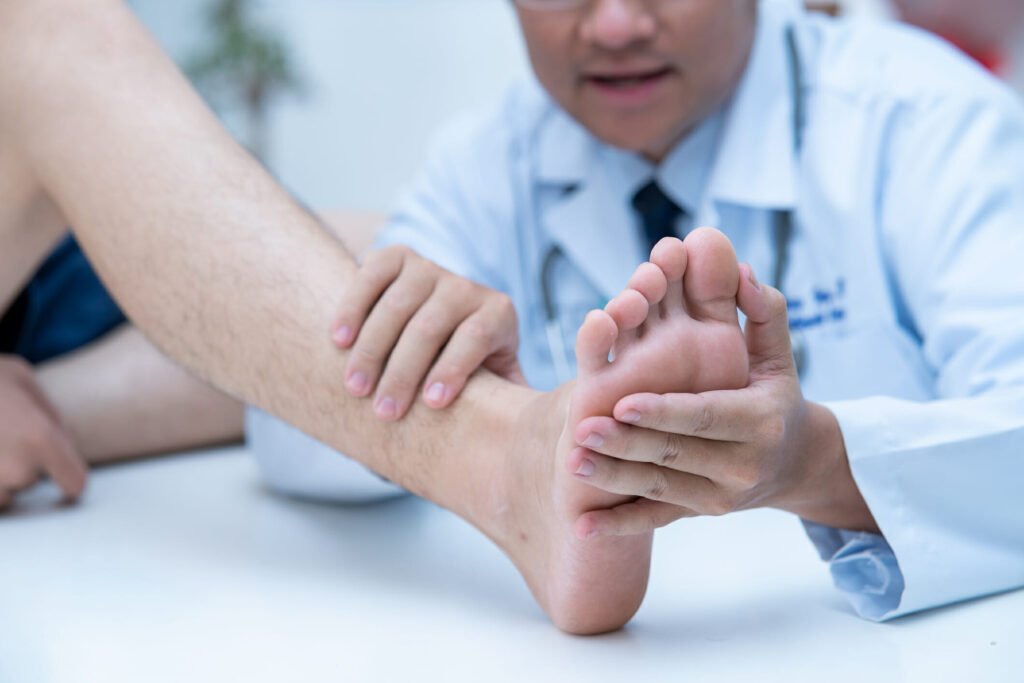A foot doctor is commonly referred to as a podiatrist. Just as the name suggests, these professionals specialize in diagnosing and managing issues related to the feet and ankles. Read more: https://www.coveorthopaedics.com.sg/dr-sean-ng/
But, what exactly do foot doctors treat? And when should you visit your foot doctor in Singapore? Those are the questions we’re going to answer on this page. Keep reading!
What is the most Common Problem Treated by a Podiatrist?
If this is the first time you’re being referred to a foot doctor in Singapore or you’re planning to see one you may be itching to ask; what is the most common problem treated by a podiatrist?
The answer is plantar fasciitis which is one of the most common causes of heel pain. Plantar fasciitis occurs when the plantar fascia, becomes inflamed. Plantar fascia is the thick band of tissue that connects the heel to the toes and supports the arch of your foot.
If you have plantar fasciitis, you may experience stabbing pain, especially in the morning or after long periods of inactivity. Your foot doctor in Singapore can treat plantar fasciitis by prescribing custom orthotics, physical therapy, and sometimes corticosteroid injections to reduce inflammation.
They may also recommend stretches and exercises to improve flexibility strengthen the foot muscles, and reduce the risk of recurrence. Here are a few other issues that may warrant a visit to a foot doctor in Singapore;
- Bunions
A bunion is a bony bump that develops at the base of the big toe. It can cause the toe to lean inward toward the other toes. This deformity can cause not just pain, but also swelling, and discomfort, particularly when wearing tight shoes.
Treatment options offered by podiatrists include recommending comfortable, well-fitting footwear, prescribing custom orthotics, and using pain relief measures like anti-inflammatory medications. In severe cases, surgery may be required to correct the deformity and reduce the pain.
- Heel Spurs
Heel spurs are calcium deposits that form on the underside of the heel bone. They often accompany plantar fasciitis and can cause sharp pain during activities like walking or running.
Treatment includes non-surgical methods like stretching exercises, physical therapy, and wearing padded footwear. In more severe cases, surgery may be considered.
- Sprains and Strains
Sprains and strains are common foot and ankle injuries, especially for athletes or those involved in physical activities. A sprain occurs when the ligaments that connect the bones in the foot or ankle are stretched or torn.
On the other hand, a strain involves the muscles or tendons. A podiatrist will assess the severity of the injury and may recommend rest, ice, compression, and elevation (RICE) to reduce swelling and promote healing.
They might also use braces or splints to immobilize the injured area. Physical therapy is often employed to restore strength and flexibility.
- Fractures
Foot and ankle fractures can happen due to accidents, falls, or heavy impact during sports. Symptoms include swelling, bruising, and severe pain which can make it difficult to walk or bear weight on the foot.
If you’re referred to a foot doctor in Singapore for a fracture, they may use X-rays to diagnose the condition and determine whether surgery is needed. In most cases, they will opt for non-surgical treatments like casting, immobilization, and recommending rest. However, in severe fractures, surgery may be required to realign and stabilize the bones.
- Diabetic Foot Ulcers and Infections
Diabetic foot ulcers are open sores that can develop on the feet due to poor wound healing. These ulcers are prone to infections, which, if left untreated, can lead to serious complications.
Podiatrists treat diabetic foot ulcers through wound care, prescribing antibiotics, and sometimes performing minor surgeries to remove infected tissue. They also provide custom shoes or insoles to prevent further pressure on the affected area and reduce the risk of recurrence.
- Ingrown Toenails
Ingrown toenails happen when the edge of the toenail grows into the skin. Depending on the severity, this condition can cause pain, swelling, and sometimes infection.
Ingrown toenails can be caused by improper nail trimming, tight shoes, or injury to the toe. Podiatrists offer several treatment options for ingrown toenails, such as lifting the nail, removing part of the nail, or prescribing antibiotics to treat infections. In severe cases, minor surgery may be required to permanently prevent the nail from growing back into the skin.
- Fungal Infections
Fungal infections, such as athlete’s foot or toenail fungus, are common foot problems that can lead to itching, redness, and nail discoloration. Podiatrists in Singapore treat these infections using topical antifungal medications or oral prescriptions for more severe cases.
In addition to medical treatment, they may recommend proper foot hygiene practices and breathable footwear to prevent future infections. Regular follow-ups are essential to ensure the infection is completely resolved.
- Flat Feet in Children
Flat feet occur when the arch of the foot doesn’t develop properly. This may lead to the entire foot touching the ground when standing.
While many children outgrow flat feet, some may require treatment if it causes pain or affects their mobility. Podiatrists diagnose flat feet by examining the child’s feet and gait.
Treatment options may include custom orthotics, physical therapy, or stretching exercises to help strengthen the muscles and improve foot alignment.
- Gait Issues
Gait abnormalities in children, such as pigeon-toeing or toe walking, can impact their overall development and posture. Podiatrists assess these issues and provide treatment plans that may involve physical therapy, corrective shoes, or custom orthotics to help improve the child’s walking pattern.
Early intervention is important in managing pediatric foot problems to prevent long-term complications.
When to Visit a Foot Doctor in Singapore
It’s not always easy to know when to see a foot doctor in Singapore. However, there are certain signs that should prompt a visit.
We strongly recommend seeking specialized care from a foot doctor if you experience chronic foot pain, swelling, difficulty walking, or notice visible deformities. Podiatrists are trained to identify and treat a wide range of foot problems.
So promptly seeing them for early intervention can often prevent more serious complications. You do not want to ignore foot issues as this may lead to further damage and discomfort.
In fact depending on the severity, it can even make it harder to walk or engage in daily activities. Regular check-ups, especially if you’re living with underlying conditions like diabetes or sports-related injuries, can help maintain optimal foot health and ensure mobility.
Final Thoughts
Foot doctors in Singapore treat a wide range of conditions, from minor skin issues to complex injuries and diabetic complications. If you’re experiencing foot pain or discomfort, visit a podiatrist to get the treatment you need to stay active and maintain healthy feet.
Cove Orthopedic Clinic – Mount Elizabeth Orchard: Orthopedic Surgeon
3 Mount Elizabeth, #14-13 Medical Centre,
Singapore 228510
Front Page 2022
+65 9631 7637



